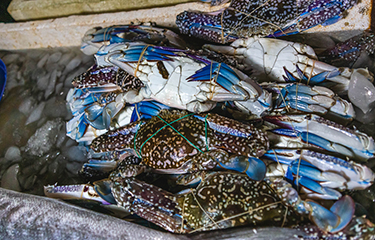Reports indicate decline in Indonesian blue swimming crab stock, concerning value distribution trends

Two new reports indicate that blue swimming crab stocks in Indonesia are declining in many areas and that social issues remain a concern for the health of fishing communities and the stability of supply chains, even though there are positive economic indicators toward better management and governance of the stock.
In 2022, Indonesia’s crab exports brought in over USD 450 million (EUR 420 million), according to Indonesia’s Ministry of Marine Affairs and Fisheries, while the country’s blue swimming crab fishery supports a supply chain that includes 65,000 fishers, 400 production plants, and 18 processing companies under the Indonesian Crab Management Association (APRI).
Although these metrics and the sheer number of players involved in the fishery may prompt optimism for the stock, both the fourth edition of The Blue Crab Consortium’s 2022 State of the Fishery report, which received funding from the David and Lucile Packard Foundation and the Walton Family Fund, and the Impact Institute’s Value Distribution Across Fish Supply Chains: Blue Swimming Crab, Indonesia report, which also received funding from the Walton Family Fund, tell another story.
“Building upon the foundational desktop research conducted by the Impact Institute, we’ve validated their findings and built on them with our own set of 14 carefully chosen indicators,” said Stuart Green, the founder and CEO of U.K.-headquartered oceans governance advisory firm BlueGreen Advisors, who headed the State of the Fishery research. “These indicators cover key facets of the fishery, including its health, economic viability, governance structures, and human rights considerations.”
Despite positive advances made in management practices of the blue swimming crab fishery, the stocks assessed by the State of the Fishery Report showed signs of decline. Indicators for proper fishery health show a decline in both the percentage of the fishery that can spawn in a given year and how much effort fishers had to put into catching a kilogram of fish.
Additionally, the Impact Institute’s report, which focused on value distribution within the fishery, found that Indonesian crab fishers are underearning compared to the average global wages for fishers.
“The Indonesian blue swimming crab supply chain presents a relatively unequal distribution of value along the steps,” the Impact Institute report stated. “Fishers earn around 48 percent of a can of processed crab. Aggregators, namely collectors and mini plants, accrue approximately 5 percent. Finally, processors accrue almost 47 percent of the value of a can. There is underearning present in the fishery, with an estimated 61 percent of blue swimming crab fishers earning below the national living income for a typical rural family. Future studies are recommended to include questions regarding sustainability since there is currently a lack of data in this regard.”
High costs associated with the fishing process and low yields could be factors in the complex dynamic in which fishers are receiving a relatively high percentage of their catch’s total value, but still underearning to the point of living in poverty, the report explained. The Covid-19 pandemic also heavily affected the fishery, and it’s still attempting to bounce back from its effects.
Better access to financing or a cooperative group savings model could help address these issues, with the report also recommending greater engagement of supply chain companies to support stable, healthy producer communities, increase data development and sharing, and promote traceability in the supply chain.
There is infrastructure in place to help slow – and reverse – the trends present in the alarming data, including the introduction of harvest strategies developed by the Ministry of Marine Affairs, which came into force in 2021 and the establishment of minimum size and weight regulations. The State of the Fishery report also found signs of progress at the local governance level, as adaptive management committees have been working closely with provincial governments, and even village-level interventions taking place.
Furthermore, economic indicators for the fishery are trending positively in three areas: Government spending on the fishery increased over the last two years, the value and amount of blue swimming crab exports increased, and the percentage of “jumbo” lump meat coming out of the stock also spiked.
The Blue Crab Consortium will also be working to improve data to better support the sustainable management of blue swimming crabs in Indonesia and believes that the trends it has found are by no means irreversible.
“Looking ahead to 2024, our focus expands to encompass technological advancements, refining management practices, and gleaning insights from diverse fisheries,” the Blue Crab Consortium report stated. “These lessons will chart a course for responsible fisheries management, contributing to marine ecosystem health and the prosperity of communities dependent on them. As we approach our sixth year, we’re poised to leverage insights from the complete dataset, embarking on a journey to promote sustainable fisheries management in Indonesia.”
Photo courtesy of Travis182/Shutterstock





Share